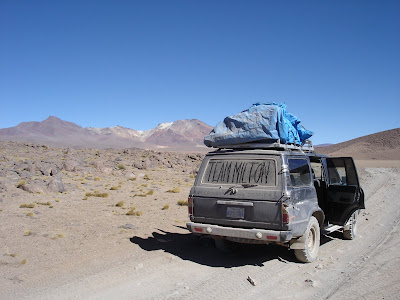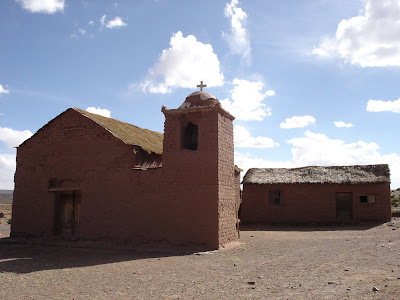








This is Sambo, the spider monkey











This is Sambo, the spider monkey







 We nearly didn't get to leave as the night before we left our car got run into by a drunk, off duty, Bolivian policeman ( as you do). Poor old Milton, our driver, was unlikely to get any help with paying for the damage and was up at 6am to get the door fixed. In the end it was OK, but we set off 2 hours late... I spent my time hanging out with the local ladies........
We nearly didn't get to leave as the night before we left our car got run into by a drunk, off duty, Bolivian policeman ( as you do). Poor old Milton, our driver, was unlikely to get any help with paying for the damage and was up at 6am to get the door fixed. In the end it was OK, but we set off 2 hours late... I spent my time hanging out with the local ladies........
To get there, we went from Tupiza, a slightly different tour to most but I think worth it. You climb up and up endlessly and it´s a little hairy at times as you head through the Quebradas and to the flat plains beyond at a high altitude of about 4300m. This part was just full of amazing rock formations from millions of years of erosion.


 The little black cirlcles on this photo is wher¡e llamas have been to the toilet. They only like to go where one has been before
The little black cirlcles on this photo is wher¡e llamas have been to the toilet. They only like to go where one has been before

 The llamas are cute, but they also taste nice and there´s thousands of them so we figured it´s ok to eat them. These ones had pink ribbons on their ears for a Pachamama festival.
The llamas are cute, but they also taste nice and there´s thousands of them so we figured it´s ok to eat them. These ones had pink ribbons on their ears for a Pachamama festival. Donkey meat is a 10th of the price of llama meat so the locals dry it and mix it up and then sell it at a profit in the city. On route we found a spot where they´d been doing this. The huge pile of llama and donkey bones proved alot of fun. I'm a little worried about the 'beef' we had for dinner in our stew that night, because it was different from any I've ever had before.....
Donkey meat is a 10th of the price of llama meat so the locals dry it and mix it up and then sell it at a profit in the city. On route we found a spot where they´d been doing this. The huge pile of llama and donkey bones proved alot of fun. I'm a little worried about the 'beef' we had for dinner in our stew that night, because it was different from any I've ever had before..... 





The next day, after a freezing cold night´s sleep, or none in my case, we got up at 5am to set off. We drove through very arid desert like plains past Dali-esqu fields of weathered rocks and finally reached our lunchtime destination, 37 degree hot springs! Needless to say no one wanted to get out for lunch!

After lunch we finally got to see flamingos grazing in the lagunas. The lagunas vary in colour (pink, blue, green, white) depending on the mineral deposits found in them. The minerals are mined in places, but not enough to destroy the rugged beauty of the area. The highest point we reached was about 5000m where we saw sulphurous mud geisers, spewing out a eggy farty stench. It was so cold there was snow falling. From red hot deserts to snow all in one day....




The 2nd night saw us in our most basic accomodation, but at least this time we had booze, a fire and Ben and Kate, and Chris and Marcia from the other jeep to keep us company and play cards with. Rum and coca tea is a surprisingly good combo. We also got a lie in of sorts, till 7am

The 3rd day saw travelling past more lagunas, more flamingos and more amazing rock formations and finally ending up to a salt hotel (yes a hotel made of salt) on the banks of the salt flats themselves where we finally got a shower, had an amzing meal of quinua soup followed by some llama steak (tasty!) and were subject to some tourist tax by local school kids on some pan pipes.
 The sunrise over the salt flats was amazing,and the day just kept getting better. Over dinner the night before we had questioned wether or not the salt flats could be any better than all the fascinating scenery we had seen over the last 3 days. How wrong we were. Its hard to express just how huge an expanse of nothingness it is, or how beautiful its is. I hope the photos do it justice.
The sunrise over the salt flats was amazing,and the day just kept getting better. Over dinner the night before we had questioned wether or not the salt flats could be any better than all the fascinating scenery we had seen over the last 3 days. How wrong we were. Its hard to express just how huge an expanse of nothingness it is, or how beautiful its is. I hope the photos do it justice. 
 The most amazing thing is the perfect geometry of the hexanol crusts where the summer rains have evaporated. Another crazy unexplained phenomena is the humming birds that manage to make it across to germinate the flowers of the 1000 year old cactii in an island at the centre of the flats. Normally humming birds have to feed every 3 seconds or so because of their high metabolism and tiny little bodies....
The most amazing thing is the perfect geometry of the hexanol crusts where the summer rains have evaporated. Another crazy unexplained phenomena is the humming birds that manage to make it across to germinate the flowers of the 1000 year old cactii in an island at the centre of the flats. Normally humming birds have to feed every 3 seconds or so because of their high metabolism and tiny little bodies.... We had a lot of fun gooning about making taking photos that took advantage of the distortion of perspective.
We had a lot of fun gooning about making taking photos that took advantage of the distortion of perspective.


I suppose I should give a little explanation of what the slat flats are. They were caused by the receding and evaporation of an enormous inland lake, which left huge deposits behind. They are 12500 square kilometres in size (a million and a half footy pitches), and the salt is about 8m thick. The locals mine 20000 tons a year of it, scraping it off into little piles and carting it away. This may change with the fact that there is huge quantities of lithium there too, but lets hope that big business doesnt spoil the beauty of the place.

 A massive thank you has to go to our driver, Milton, and cook Jessica who made it such a great 4 days
A massive thank you has to go to our driver, Milton, and cook Jessica who made it such a great 4 days 